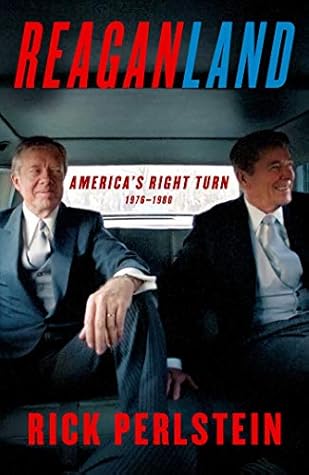More on this book
Community
Kindle Notes & Highlights
Read between
January 3 - March 15, 2022
blue-collar voters were vulnerable to conservative appeals because they were “no longer solely motivated by economic concerns—which have traditionally made them Democrats.” Now that they feared “change in society” more than losing their place in the middle class, they were “one of the most vulnerable groups in the Democratic coalition.”
“We organize discontent.” Organizing discontent meant foraging for whatever issues roused an otherwise apathetic citizenry to conservative political action. Presently, social issues were it.
It was among the most sweeping political reform proposals in U.S. history—and soon afterward, legislators from both parties stood together at a news briefing to endorse all or most of it.
No, business’s backlash, its emergence as a klasse an sich, came a little bit later, in response to a new, and different, sort of liberalism—one whose buzzwords were “environmentalism” and “consumerism,” and which, unlike Lyndon Johnson’s War on Poverty, placed corporate power squarely in its sights.
It was a magnificent specimen of what made Reagan such a valuable figure on the right: his ability to effortlessly package the quest for corporate profit into an uplifting vision of a righteous citizens’ crusade.
Its name was supply-side economics.
AT THE END OF MAY in the Chicago suburb of Lincolnshire, with the vote in California a week way, two hundred activists met at a National Tax Limitation Conference. An aide for one of sponsors, the American Legislative Exchange Council, an organization controlled by Paul Weyrich that wrote conservative “model legislation” for state legislators to introduce, described tax limitation as the perfect issue to build a broader conservative movement—to organize discontent: “It crosses all philosophies. Everybody is concerned with the increase in taxes.”
Following Watergate a new cadre of idealistic reformers were swept into Congress and stripped the old bulls of their leadership positions. They increased the number of committees and subcommittees and passed a rule that members could not chair more than one, increasing the number of “leaders.” They opened most congressional committee meetings to the public and made it easier to successfully file Freedom of Information Act requests. They passed campaign finance reforms requiring public disclosure of all campaign donations, limiting individuals to $2,000 per candidate per election. All these
...more
This highlight has been truncated due to consecutive passage length restrictions.
The Federal Elections Campaign Act Amendments of 1974 made it easier to form political action committees—legal entities that pooled stakeholders’ individual contributions. This reform was specifically requested by labor unions, who believed it could help them dominate political fundraising because they had the ability to coordinate donations from members. But the organizations that found it easiest to coordinate donations were corporations—whose employees had to please the boss or lose their jobs. Some corporations merely “invited” employees to deduct PAC contributions straight from their
...more
Though that brought an irony: independent-minded voters tended to pick candidates like they would a consumer product. That made advertising much more important.
It felt like the bill was coming due for a generation of economic boom times that had secretly been built on a foundation of death.
A HISTORIAN ONCE CALLED HIS book about the 1970s It Seemed Like Nothing Happened. Certainly it seemed so compared to the 1960s, when new revolutions seemed to burst forth every month. But in fact enormous things were happening. They just weren’t always the sort of things that made for bold, clear headlines. Corporations withdrew their support for the liberal state and politicians embraced capital gains tax cuts; fundamentalist ministers inched their way into partisan politics and conservatives crept ever closer to control of the Republican Party; the Democrats fell into ideological confusion
...more
And on December 18, 1978, came another of those quiet revolutions that helped rewire the invisible structures that govern the world: the United States Supreme Court, in Marquette v. First of Omaha, let banks charter themselves anywhere, rendering state laws capping credit card interest rates moot—meaning that not paying your credit card would cost more than ever before.
Symbols of middle American normalcy kept rearing up and strangling America’s sense of itself as decent, prosperous, and safe. The Kool-Aid that Jim Jones used to poison his followers. The Twinkies that supposedly turned Dan White into a homicidal maniac. Family farmers invading Washington, D.C. A necrophile birthday clown. The year 1979 was when the pure products of America went crazy.
The group’s only non-clergyman, Robert Bellah, a Harvard sociologist with a preacherly bent, had coined the phrase civil religion, and had recently published an essay on America’s “covenantal” tradition, by which he meant a commitment to the communal public good that persevered alongside America’s less elevated ethic of market-based self-interest. Bellah argued that America’s covenantal side must be restored in order to transcend the “mood of vindictiveness and repression rather than generosity of spirit,” which “could lead to the end of free government in America.” The imprint of that essay
...more
Like the time, visiting Lincoln’s tomb in Springfield, he performed an Illinois political tradition for the cameras: rubbing the Great Emancipator’s bronze nose for luck. He began answering a pool reporter’s question about the hostages—and Nofziger nearly knocked them over hustling the great man away. On the bus, another press officer, James Brady, defended the practice. “We have our own agenda. We don’t want a story to break before we were ready to communicate it to the market.”
Which further inflamed evangelicals’ martyrdom, making them work all the harder.
The 17 percent of voters who cited the crisis in Iran as the most important issue preferred Carter—by a heaping a margin of two to one. Carter won the hostage issue. The ironclad conventional wisdom was wrong. Perhaps, more than posterity appreciated, people respected Carter’s grinding, sedulous efforts to negotiate a favorable outcome with people who appeared to be lunatics, keeping the hostages alive and unharmed.


